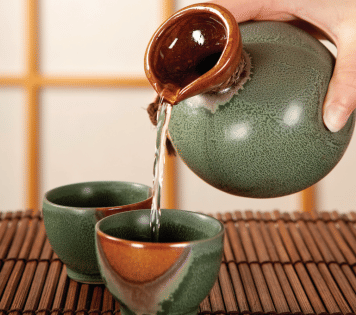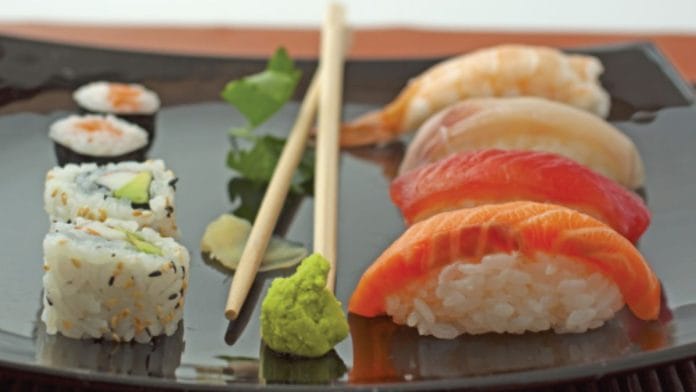Sometimes, street food is elaborate and expensive; at other times, simple and cheap. Sushi, too, can be either.
It is thought that during the second century CE near the Mekong River, in landlocked parts of China, Laos and northern Thailand, salted fish was placed between layers of cooked rice. The container was sealed for a lengthy period of time, during which the salt, and rice fermentation, preserved the fish. The rice was discarded before consuming the fish, although a few aficionados enjoyed the intense aroma (much like blue cheese). The preparation time and costs involved made this food for the wealthy. For those who lived near the water, acquiring fish was much easier.
This sushi style migrated to China and Japan in the seventh century. The Japanese ate the rice and the fish, while the Chinese did not take to it. Increasing popularity for this rice/fish combination in Japan resulted in shorter preservation times, so as to keep up with demand. While the fish was still protected from bacterial contamination, the rice became much more palatable. In 718 CE, sushi was acceptable to the government as a form of tax payment. By the early seventeenth century, sushi rice was seasoned with a revolutionary new product: vinegar made from rice, ‘rice wine vinegar’ (which actually has nothing to do with wine).
Seasoning the rice with rice wine vinegar permitted fish and rice to be eaten together because the rice wine mimicked the flavour of fermented rice, and had preservative qualities as well. Sushi consumption had also become much less expensive and more democratic, moving from the aristocracy to the labourers who frequented street markets at lunchtime. Simple rice and fish combinations as well as elaborate bento boxes of prepared sushi, with pickles and other condiments, were ready to be eaten anytime.
After the Second World War, sushi stalls and carts in Japan were moved indoors to more sanitary conditions. As Japanese restaurants proliferated, sushi began its global migration while adapting to newer environments, giving rise to the California roll, the inside-out roll and sushi with brown rice. Top sushi chefs are very particular about which rice they use, and some even polish their own rice (top-grade short or medium-grain rice). Apprentice sushi chefs begin their long training by learning to prepare rice.
Sushi is served from high-end restaurants to institutional cafeterias, and can be purchased at supermarkets and at stores that sell only pre-packaged sushi. This style of sushi is prepared in factories where robots mould the rice into individual oblongs or rolls. Trained staff add sliced fish. The use of frozen farmed fish and lesser-quality rice has brought the price of sushi down from food for the wealthy to food for the masses. As a result, sushi is almost global in its reach. Some sushi restaurants use conveyor belts that move around a circular counter: customers take small plates as they pass by.
Perhaps the best example of the sushi explosion is in São Paulo, Brazil, which has an abundance of sushi restaurants. Japanese immigrants first came to work in this area on coffee plantations in 1908. The Japanese population grew, and today São Paulo has the largest such community outside of Japan.
Seventeen million sushi meals are eaten every month. In Brazil, sushi began as a luxury product for wealthy diners. As its popularity increased, automation of rice and fish brought the price down. Cafeterias and salad bars now offer sushi. One change that reflects the background of Brazil’s history with rice is the preference for serving long-grain rice with Japanese foods other than sushi. Outside of Asia, Brazil has one of the highest consumptions of rice: 40 kg (88 lb) per person annually. And sushi is often prepared using Brazilian ingredients to reflect local tastes: mango, strawberry and raw beef.
Sake
Fermented rice and water combinations have existed in China and Korea for millennia, but Japanese sake – the one with which we are most familiar – began about 2,500 years ago. Moulds, fermentation and wild yeasts, and the even earlier chew-and-spit technique, were used to ferment brown rice and water into gruels that were strained. The resulting brew was light brown and cloudy. In AD 689, the new brewing department at the Imperial Palace, along with Chinese help, developed moulds that increased alcohol content. The ritualistic aspect of sake drinking solidified when Shinto monasteries became legal breweries in their own right.

During the next 400 years, sake brewing became a business. Kyoto and Kobe became major brewing centres. Government taxes ensued. In the late 1500s, when rice began to be polished, sake could be made either cloudy or clear. By the 1800s, just as with single malt scotch, wine and cheese, local conditions – including time of year, rice type, terrain, climate and water – influenced the flavour of sakes, and local sakes came to be preferred by different consumers.
During periods of rice shortage (the Second World War, for example), mixing a small amount of rice with distilled, cheap alcohol produced low-quality sakes. After the Second World War, whiskies, wine and beer became popular in Japan, while sake became more popular in Europe, South America, Australia and the U.S.
Sake came to Hawaii in 1885 with Japanese labourers on sugar plantations. Import taxes kept increasing, so Japanese-owned breweries were built on American soil. Initially intended to increase sales, lesser-quality sake was produced. This sake was heated, which helped disguise its poor quality. Other deviations from Japanese etiquette included drinking sake with sushi. Not only does traditional sushi etiquette dictate that sake not be drunk with sushi (‘like with like’ is frowned upon in some etiquette circles), but high-quality sake should be served chilled, with vintages and other labelling information available to connoisseurs.
 This excerpt from ‘Rice: A Global History’ by Renee Marton has been published with permission from Pan Macmillan India.
This excerpt from ‘Rice: A Global History’ by Renee Marton has been published with permission from Pan Macmillan India.






